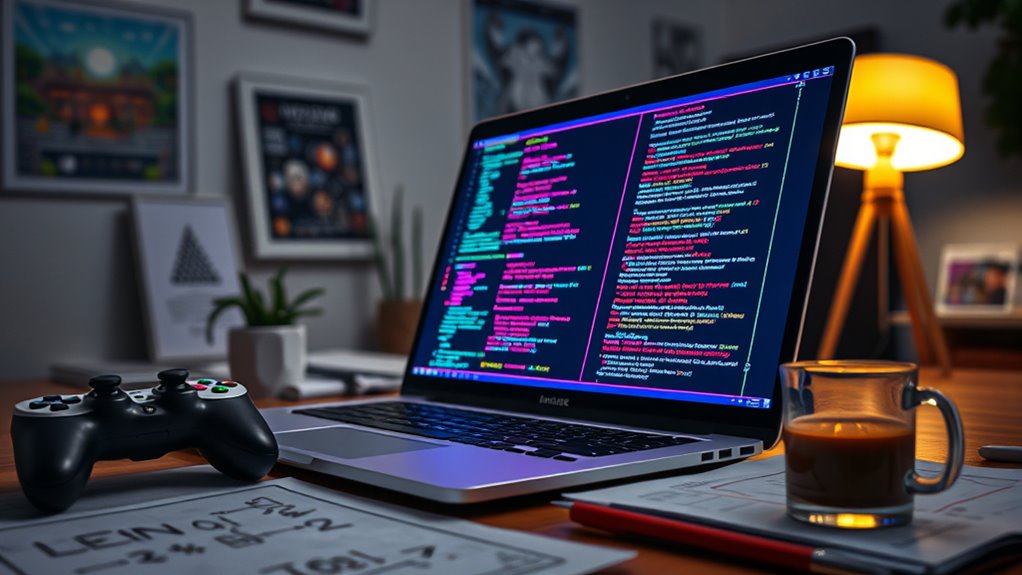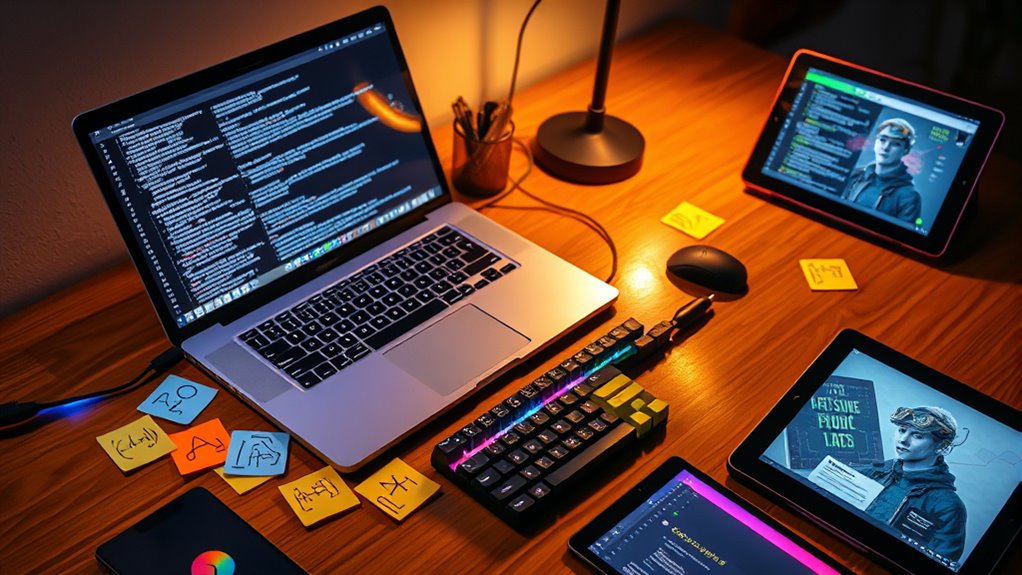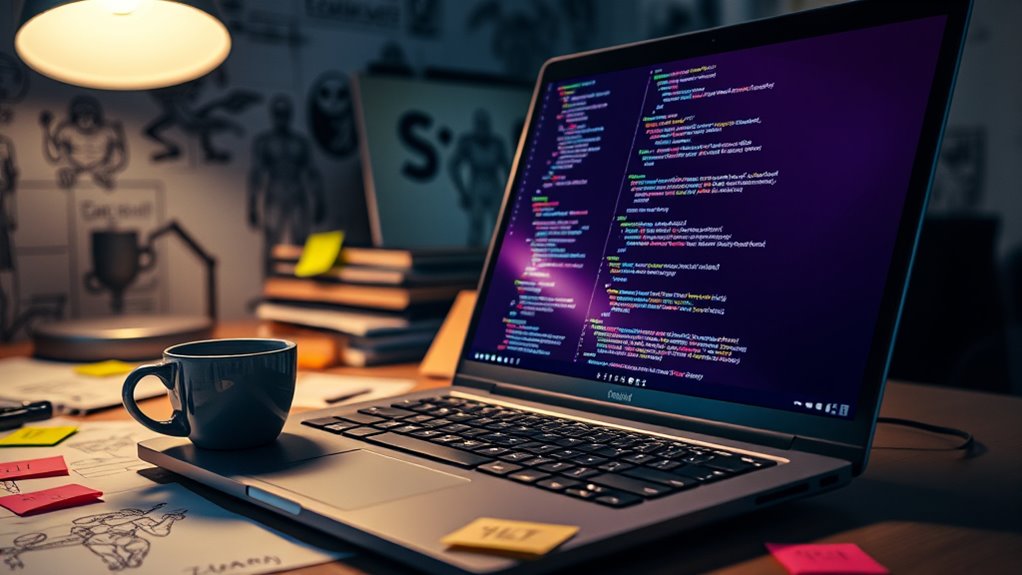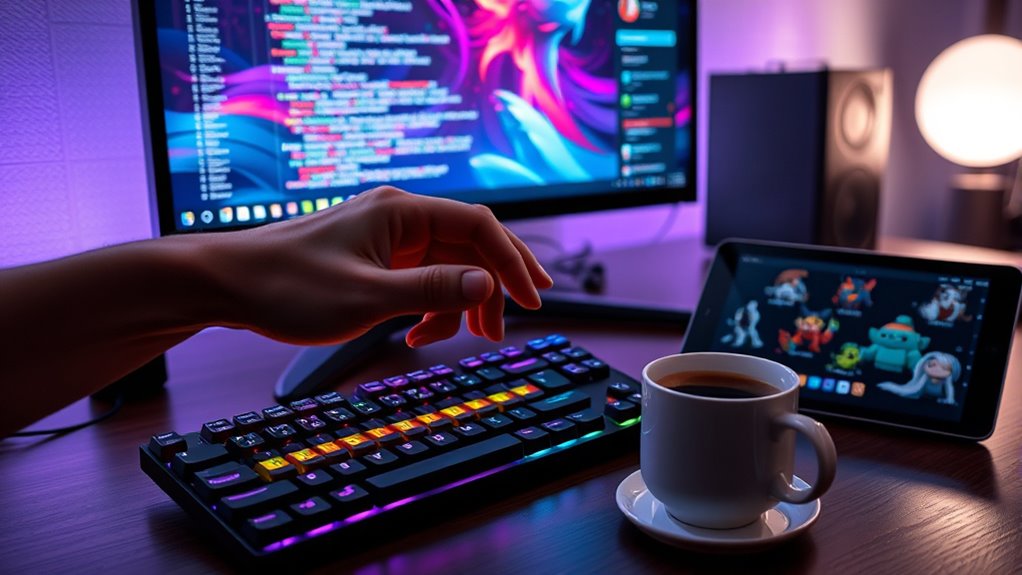To use vibe coding for game development basics, start by describing your game features in natural language. This makes coding more accessible and faster. Next, set up your environment with the right AI tools and libraries, like Pygame or Three.js, to facilitate your project. As you implement AI-assisted coding techniques, focus on your ideas rather than syntax. Remember, the quality of your prompts is essential for accurate outputs. Discover more about optimizing your workflow and leveraging AI effectively.
Key Takeaways
- Use natural language prompts to describe game features clearly, allowing AI to generate relevant code quickly and effectively.
- Select user-friendly AI tools and libraries, such as Pygame or Three.js, to streamline game development processes.
- Focus on the creative aspects of game design, leveraging AI to handle coding details and syntax.
- Maintain clarity in prompts to avoid inaccuracies in the code generated by AI, ensuring quality output.
- Review and refine AI-generated code regularly to address potential bugs and improve overall game functionality.
Understanding Vibe Coding in Game Development

Vibe coding is revolutionizing game development by allowing you to describe features in natural language, which AI then translates into code.
This prompt-driven approach works best for simpler tasks, like basic movement and game loops. You can quickly prototype and explore features, saving time and simplifying your workflow. It makes game development more accessible, enabling you to focus on design rather than the nitty-gritty of coding. Additionally, the development of unique ship types has been streamlined through Vibe coding, enhancing the overall gameplay experience. However, you’ll need to craft clear prompts, as imprecise ones can lead to inaccuracies in the generated code. While there may be a learning curve in communicating with AI tools, the benefits of flexibility and rapid iteration can greatly enhance your game development experience.
Setting Up Your Game Environment

After grasping the basics of vibe coding, it’s time to set up an effective game environment that supports your creative vision.
Start by selecting the right AI tools, like Grok or Cursor, to help plan and build your game framework. Depending on your game’s needs, utilize libraries such as Pygame for 2D environments or Three.js for 3D. Understanding basic programming concepts will simplify your coding process and enhance your overall game development experience.
To streamline the coding process, consider using voice dictation software. Keep your tech stack simple to minimize errors, and provide clear initial prompts to guide AI-assisted coding.
This setup will lay a solid foundation, allowing you to focus on developing your game’s unique mechanics and features while leveraging the power of AI to enhance your workflow.
Utilizing AI Tools for Game Conceptualization

In the domain of game development, leveraging AI tools can revolutionize how you conceptualize your ideas. Tools like Ludo.ai help you generate game concepts quickly from keywords or existing titles, eliminating creative blocks. You can use natural language prompts to guide the AI in structuring game mechanics, storylines, and character details, enhancing your creative process. Additionally, AI can aid in generating concept art, gameplay screenshots, and 3D models, enriching the visual appeal of your games. Some AI tools even integrate real-time market insights, allowing you to tailor your concepts to specific audiences. By utilizing these capabilities, you can streamline your ideation process and create compelling game experiences more efficiently.
Implementing AI-Assisted Coding Techniques

While traditional coding often requires meticulous attention to syntax and structure, implementing AI-assisted coding techniques allows you to focus on creativity and intent. By leveraging AI-generated code, you can translate natural language prompts into functional code quickly, streamlining your development process.
This means you can iterate and explore game concepts without getting bogged down by manual coding. However, keep in mind that while AI speeds up development, challenges such as code quality and debugging persist.
Integrating AI tools with your game engine can also enhance features like predictive analytics and intelligent decision-making. Embracing these techniques fosters collaboration between you and AI, leading to innovative game mechanics and richer player experiences.
Managing Your Vibe Coding Workflow

To effectively manage your Vibe Coding workflow, start by establishing a clear project plan that outlines your game’s objectives, mechanics, and target audience.
Utilize AI tools like Grock for concept development and rule creation, ensuring you define game mechanics and objectives clearly. Create a detailed project plan using AI suggestions, including the game type and genre. Additionally, consider incorporating AI integration in healthcare to enhance user engagement through personalized gameplay experiences.
Organize your workflow with platforms designed for project management to maintain efficiency. Leverage tools like Cursor for setting up frameworks and Wispr Flow for voice-activated coding. Version control systems like Git are essential for tracking changes and ensuring code integrity throughout the development process.
Don’t forget to implement version control systems like Git to track changes. Prioritize consistency in your tool selection for a smoother workflow that enhances collaboration and productivity throughout your development process.
Advantages and Limitations of Vibe Coding

As you explore Vibe Coding, you’ll discover a range of advantages that can transform your game development process. It speeds up development, allowing you to generate complex code in seconds. You don’t need extensive programming knowledge; just describe your ideas in natural language and watch them come to life. Prototyping becomes a breeze, turning what once took weeks into mere hours. Furthermore, the use of natural language prompting enables developers to express desired features in everyday language, making the process even more intuitive.
However, be mindful of limitations. Your success hinges on the AI’s capabilities, and vague prompts might lead to inaccuracies. Additionally, you’ll need some technical understanding to guide the AI effectively. Quality control is crucial, as you’ll need to review and refine the generated code to guarantee it meets your vision. Balancing creativity and precision is key.
Frequently Asked Questions
Can I Use Vibe Coding for Mobile Game Development?
Yes, you can use vibe coding for mobile game development! By leveraging AI tools, you can create game frameworks and mechanics with minimal manual coding.
Just remember to use clear, specific prompts to guarantee accurate results. While mobile-specific challenges like screen size and touch input exist, vibe coding’s flexibility allows for adaptation.
With practice and iteration, you’ll enhance your skills and efficiently develop engaging mobile games.
What Types of Games Are Best Suited for Vibe Coding?
Did you know that 70% of new developers struggle with coding?
If you’re looking to create games using vibe coding, focus on 2D grid-based games, turn-based strategy games, and simple arcade games. These types leverage structured layouts and straightforward mechanics, making them easier for AI to generate code.
Text-based and roguelike games can also benefit, as vibe coding speeds up prototyping and offers innovative possibilities without needing extensive programming knowledge.
How Do I Troubleshoot Ai-Generated Code Errors?
To troubleshoot AI-generated code errors, start by identifying the root cause. If the AI’s solution seems off, take a step back to analyze the problem.
Common issues like “no module available” errors often arise, so make certain all dependencies are installed.
Use debugging strategies, such as redefining the issue or exploring alternative solutions. Engage in iterative refinement with the AI, allowing for adjustments and improvements to your code as you go.
Can Vibe Coding Integrate With Existing Game Engines?
Imagine weaving a tapestry where threads of AI and engines intertwine seamlessly.
Yes, vibe coding can integrate with existing game engines, but it may need some fine-tuning. While AI tools streamline much of the process, you might encounter compatibility challenges that require a careful touch.
Don’t worry, though—community support and evolving technology can guide you in overcoming these hurdles, making your development journey smoother and more efficient as you craft your game.
Is There a Cost Associated With AI Tools for Game Development?
Yes, there’s definitely a cost associated with AI tools for game development.
Depending on what you need, these costs can range from a few thousand dollars for simpler applications to tens of thousands for more complex integrations.
You should also consider maintenance costs, which can add up to around $20,000 annually.
Ultimately, the right tool can enhance your efficiency and creativity, making the investment worthwhile for your project.
Conclusion
In game development, vibe coding can feel like a dance between creativity and logic. You’ll find joy in the freedom it offers, yet struggle with the discipline it demands. Embracing AI tools can spark innovation, but relying too heavily on them might stifle your unique voice. Ultimately, balancing these elements is key: let your ideas flow while grounding them in structure. By mastering this interplay, you’ll create games that resonate both with you and your players.









